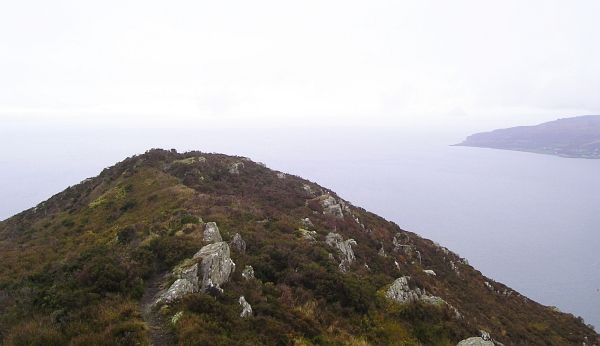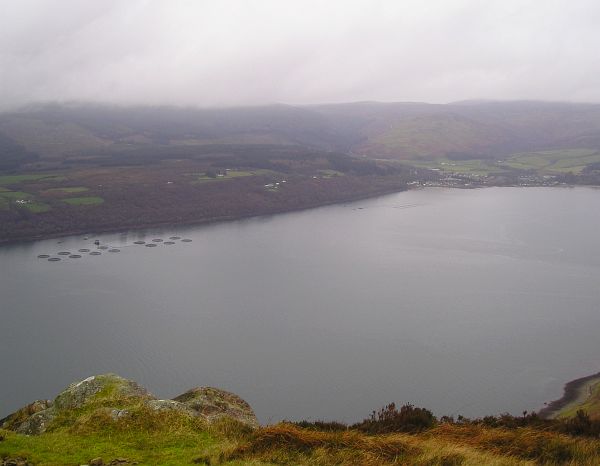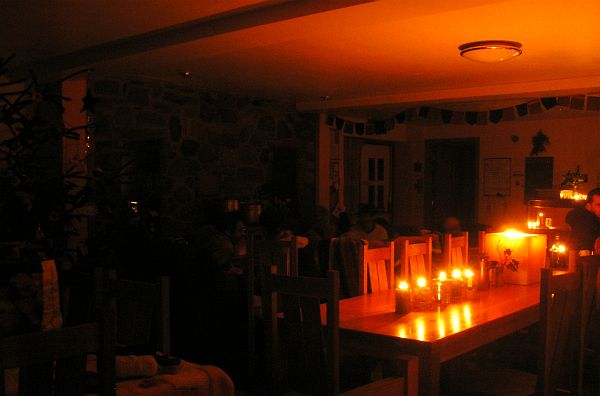Views From Holy Island
The end of a wonderful two weeks on Holy Isle. Christmas and New Year.
And it's difficult to say what makes it so good, in the midst of the constant winter gales, rain storms, and little occasional sun.
To start off, maybe it's best to say what the island doesn't have:Mechanised transport of any sort. (Except - see below)
Roads
Shops
Mobile phone service
Internet
TV
Radio
News
Outdoor lighting
Amplified sound
Alcohol/cigarettes/drugs
Fast food
And what it does have:
A small group of guests and volunteers sharing the same aim of making this a special time and place.
Top-notch vegetarian catering by dedicated expert cooks.
The shared honour of using the only wheels on the island, to fetch firewood to the dining room in any wheelbarrow you can find.
A huge real Christmas tree, reaching the ceiling, with lights.
The Freedom of the Island.
Which just leaves the winter-time photos:
The main centre for visitors is at the northern end of the island:

The main building - accommodation, office, library and kitchen/dining room. And vegetable and herb gardens.


The link to the outside world - the jetty at the end of the stupas. Ferry boat loading up.


The only 'road' on the island - one wheelbarrow wide.

The 'Peace Hall' teaching and meditation room.
A circular walk from the main building crosses the three central peaks, Mullach Beag, Mullach Mor (1026ft) and Creag Liath, in a line leading right to the southern end of the island. Which is otherwise known as 'Southend'. This is a little confusing for me, because the buildings at 'Southend' house a four-year Buddhist retreat - all strictly out-of-bounds. Not at all like the Southend I know.
The Four Directions from the highest peak, Mullach Mor:

South. Looking over Creag Liath. Isle of Arran is to the right.

West. Isle of Arran and Lamlash Bay across the water.

North. Top of Mullach Beag in foreground, the east coast of Isle of Arran beyond.

East. The west coast of Scotland in the mist.

On the way down towards 'Southend', the conical form of Ailsa Craig comes into view, 18 miles distant beyond an Isle of Arran headland.

Followed by the 'Inner Lighthouse' and the 4-year retreat in the old lighthouse buildings.

A small beach east of the retreat area gives another view of Ailsa Craig.

Two newer retreat homes and the Retreat Master's cabin. Mullach Mor at top right.
There's a little caravan-like structure between the two homes. This is a tea-house and amenity hut for builders and volunteers.
Two nights after I took this photo the winds were fierce enough to blow this hut over and down the slope, completely destroying it. There was a reflective mood in the main centre for a while on that day.

Leaving the retreat area for the coastal path back to the main centre. Mullach Mor on the right of picture.

Wild Eriskay ponies. Ailsa Craig beyond.
There are only three species of mammals living on the island (apart from humans). These ponies, Soay sheep and Sanaan goats. All completely wild.
Along the coastal path, Buddhist artists have painted intricate images of Deities and Masters on some of the larger rocks:

The yogi Milarepa

Marpa the Translator.

The ponies study Green Tara.

Gampopa.

Mullach Mor watches over the coastal path and the rock paintings.

Further along, the stupas at the main centre come into view.
A couple of photos taken during a storm:


No boats from the outside world today (nor yesterday, nor tomorrow)
There were strange stormy sunsets in angry black skies above the black hills of Arran:


This one from the inside of St. Molaise's cave. (Pron: Mo-lash-eh)
The Celtic St. Molaise lived in this cave alongside the coastal path for about ten years in the 6th century AD:


It's quite cosy inside, even the floor gets swept now and again.
Other wintertime scenes around the vegetable and herb gardens:






Two days before departure date another Atlantic storm swept in. With the forecast grim, our return to the Scottish mainland was postponed for a day and a half. Overnight it matched the most violent storm so far with no electricity in the morning. That evening everything was by candlelight and camping-style head-light.

On the delayed departure day the two-man crew made half a dozen attempts at the jetty before the remnants of the storm allowed the rigid inflatable to tie up safely.


And we were on our way to some new adventure. Another corner with something round it. (Not including the Adrossan ferry which hit the dockside the night before, leaving the car ramp the only way for pedestrians to disembark on all sailings).
Now, you may well ask, what does all this have to do with motorcycling? Or even adventure motorcycling?
Well, in the early 1960s, a Tibetan Lama called Akong Rinpoche was sent from a Buddhist community in India to the UK to establish the first Tibetan monastery here. This he did in Dumfriesshire, Scotland.
His younger brother Jamdrak, also holding senior Buddhist positions in India, was intrigued by the idea of this new monastery in 'the west'. He smuggled himself out of his community and travelled to see Akong's project.
Unfortunately, on the way, Jamdrak was seduced by the hippy lifestyles of 1960s England and went right off the rails and onto a Harley Davidson, which he rode around London for a few years while helping to run a clothing boutique. (Me, I was on a Honda CB77 mending telephone exchanges).
Akong Rinpoche, by then running the new monastery in Scotland, rescued his brother and managed to guide him back to the Buddhist path.
Jamdrak was later ordained as a monk with the name Yeshe Losal and took over the running of the monastery in Scotland. In 1992 he bought Holy Island to establish it as a 'Peace Centre' open to all visitors from all faiths or none. He had the new teaching and accommodation facilities built, established the retreats, and the rest, as they say, is history.
Except history doesn't reveal whether Lama Yeshe Losal ever loaded his Harley onto the Holy Isle ferry boat to take it over. There's no tarmac there, so probably he didn't.
